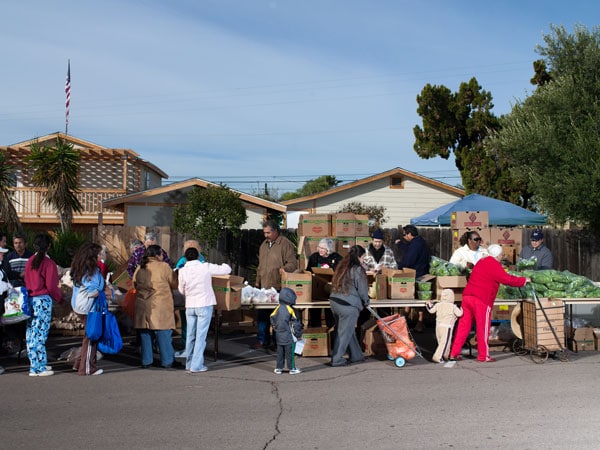There are many good stories that come out of the progressive sustainability policies in California. Most have to do with the reduction of air pollution, greenhouse gases, and the effects that increased use of solar and wind energy products has had on the US marketplace—namely, that prices have tumbled because the supply networks have ramped up their R&D and production capacity.
But the experience of the Jacobs & Cushman San Diego Food Bank (SDFB) in Miramar, California takes it to another level. Thanks to the installation of 80,000 square feet of solar photovoltaic panels in 2015 by Baker Electric Solar, this non-profit organization was able to expand and improve upon its mission of combating hunger in San Diego County.

Casey Castillo, VP of Finance and Administration, Jacobs Cushman San Diego Food Bank PHOTO: COURTESY OF BAKER ELECTRIC SOLAR
This is about more than saving money in a not-for-profit organization. It’s about being able to afford more costly fresh produce and expanding its ability to serve meals to San Diego area individuals and families. The Food Bank is now able to keep more of that food fresh due to a doubling of cooler capacity run on solar power. In other words, harnessing sunshine means healthier food for people in need. It’s the result of philanthropy—and innovative financing that enabled this solar installation to become a reality.
The $1 million cost of the solar power system, which by the way, takes advantage of the large roof of the Food Bank’s warehouse facility, was covered by a donation from Joan and Irwin Jacobs, San Diego-area philanthropists. While the specifics of the tax implications of their donations are unknown, there are now ways for non-profits to benefit further from special financing that passes through the benefits of tax savings to non-profits.

The California Solar Initiative provides incentives to outfit non-profits with solar panels, like the ones installed at the SDFB. PHOTO: COURTESY OF BAKER ELECTRIC SOLAR
Meanwhile, the SDFB has also tapped into an incentive specific to the Golden State, the San Diego-headquartered Center for Sustainable Energy (CSE), to supplement its budget. As Casey Castillo, VP of Finance and Administration for SDFB points out, because the Food Bank is able to meet targets for energy use reductions, they will receive $90,000 annually from CSE across the course of five years, a total of $450,000. “Effectively, it brings down our ROI to five years,” Castillo says. “Because we are a non-profit, that is something that also helps to bring in more donors.”

GRAPHICS: JORGE CARRILLO (PLUG), RAYMOND FELIX (KNIFE & FORK)
The 350-kilowatt solar installation, which annually removes the carbon dioxide equivalent of burning almost 600,000 pounds of coal, wasn’t a one-hit wonder of sustainability for the SDFB. Castillo describes several other measures to reduce energy use and support the organization’s LEED initiative that were already completed or in process. They include a lighting retrofit to LEDs from incandescent bulbs; installation of newer, highly efficient air conditioning units; and participation in San Diego Gas & Electric’s demand-response program, where they reduce usage in peak demand times to achieve savings.
But what Castillo is most proud about is how more meals are available to the approximately 400,000 people in San Diego County who are food insecure. “We can serve 600,000 additional meals every year because of the $120,000 saved in annual energy costs,” he says.
A handful of other food banks around the country have made use of their large roofs to do something similar, including in Houston (Texas), Contra Costa County (California), Bellingham (Washington), Washington, D.C. and Boston (Massachusetts). And that’s the way it should be, according to Kevin Weinberg, head of Baker Electric Solar commercial sales, which installed the SDFB system. The Escondido, California-based company also works on utility scale, residential as well as commercial solar installations.
“Any non-profit that handles refrigeration or has a lot of lighting such as SDFB, is a good candidate for solar,” Weinberg says. “It’s about energy consumption. If an organization has a large roof or space on the ground such as a parking lot with existing carport structures, they can benefit from solar.”

The 350-kilowatt solar installation will annually remove the carbon dioxide equivalent of burning almost 600,000 pounds of coal. The panels were manufactured by Hyundai and the inverters by SMA America. PHOTO: COURTESY OF BAKER ELECTRIC SOLAR
Weinberg acknowledges that the tax benefits make it a clearer financial advantage for for-profit businesses, which he says can shave up to 30% off the cost with a federal tax credit, and potentially an additional 35%+ off in deductions due to accelerated depreciation. He adds that electricity costs in California are set to go up—“some rates structures double energy costs” he says—such that for any company with a healthy balance sheet and intention to stay in a building with a large roof, “there’s almost no reason not to install solar.”

PHOTO: COURTESY OF BAKER ELECTRIC SOLAR
Several other trends in energy, particularly in California, suggest for-profits and not-for-profits alike will continue on the path toward adopting solar. Southern California Edison announced in late 2015 it was shifting its focus from natural gas fired plants to battery storage to accommodate peak demand periods. Such a move naturally favors solar and wind, which can produce excess capacity but not always when it’s most needed. Advancing storage technologies are a hotbed of research because of this potential.
“We have a strong set of industry and advocacy groups in California,” says Weinberg. What it boils down to is fewer emissions—and in the case of SDFB, a lot more healthy meals.
Download a PDF of this story here.
Connect with Baker Electric Solar: Website | Facebook | Twitter | LinkedIn


